Design and Development of Layered Security: Future Enhancements and Directions in Transmission
Abstract
:1. Introduction
2. Problem Statement
3. Scope of Study
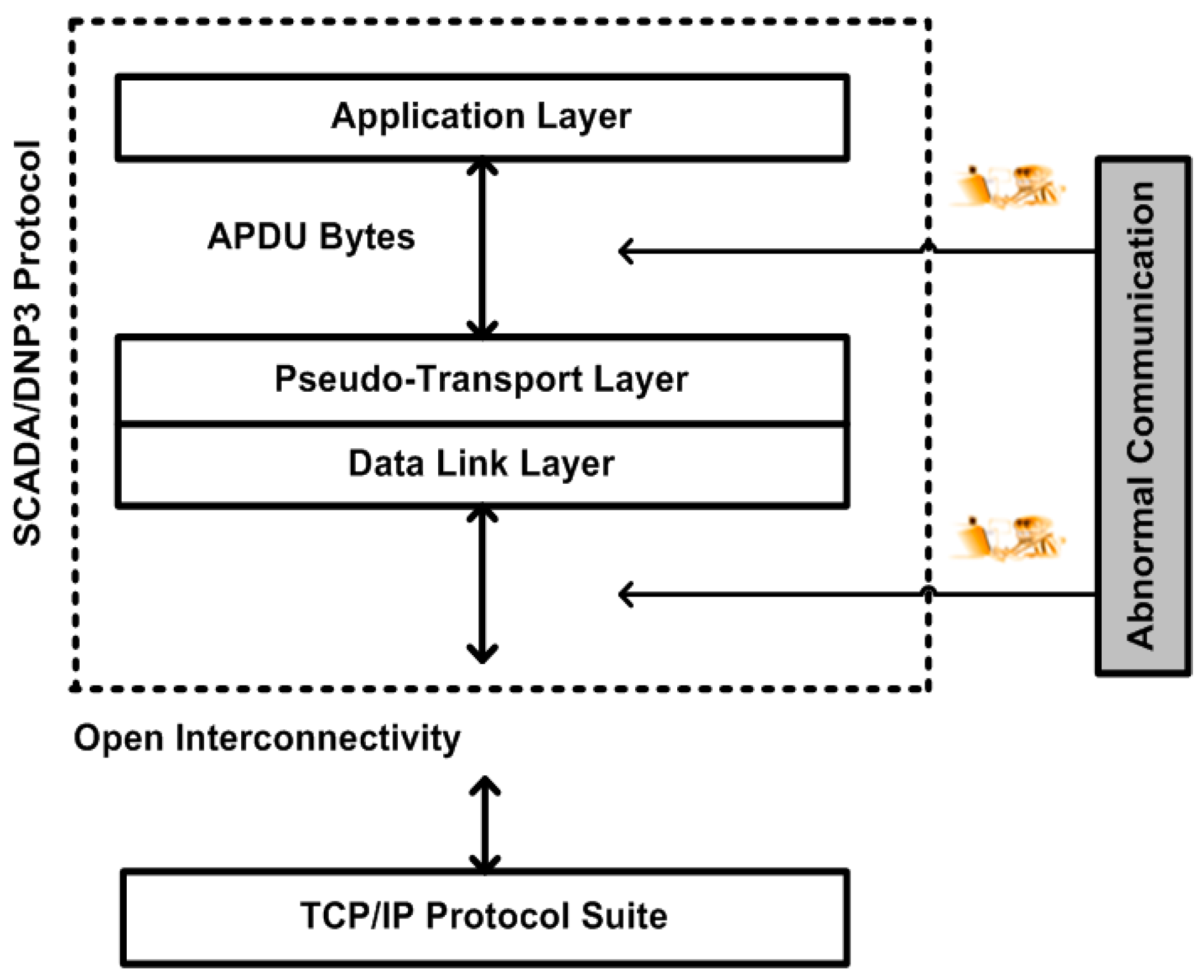
4. Research Objectives
- The bytes of the application layer or the APDU bytes are fixed at the application level; the dynamic cryptography buffer (DCB) is used for the remaining bytes after the fixing process is complete. The APDU bytes are therefore readily aligned with the pseudo-transport-layer bytes or the TPDU bytes during the transmission of the message or the bytes.
- The assemblage of the protocol bytes from the lower layer to the upper layer, whereby security is implemented and tested in terms of integrity, authentication, confidentiality, and non-repudiation at the application layer of the DNP3 protocol.
- The proposed security development is validated using formal proofs and the performance results are evaluated with security tools. The security results are also measured during the SCADA/DNP3-protocol end-to-end communication for the purposes of a performance comparison.
5. Research Contribution
6. Development of the Application Layer

MTU/RTU Communication 1 {
If Request: MTU_AC [A0, A1, A2 = 0, A3] && Response: RTU_AC [A0, A1, A2 = 1, A3]
Then Confirmation: MTU_AC [A0, A1, A2 = 0, A3]
} // Master station has initialized the request without confirmation and upon receiving the RTU response with a confirmation set (bit), the MTU also sends the confirmation.
MTU/RTU Communication 2 {
If Request: MTU_AC [B0, B1, B2 = 1, B3] then Confirmation: RTU_AC [B0, B1, B2 = 0, B3]
&& Response: RTU_AC [B0, B1, B2 = 1, B3]
Then Confirmation: MTU_AC [B0, B1, B2 = 0, B3]
} // Master station initialized the request with the confirmation set (bit) and the RTU also sends the confirmation message. Afterward, the RTU will send a response with a confirmation set (bit) upon receipt and the MTU also sends the confirmation to the RTU.
6.1. Application Protocol Control Information


6.2. Application Service Data Unit

6.3. System Model: Application Layer Development
| Notations | Descriptions |
|---|---|
| Random bytes from user-application layer or random input bytes from user-application layer. | |
| Function that defines bytes X | |
| Function that computes the application-layer header bytes or APCI bytes. | |
| Function that computes the application-layer data bytes or ASDU bytes. | |
| Computed header (h) bytes and data (d) bytes . | |
| Computed dynamic (dy) bytes via function . | |
| Function that computes the application layer fragment or APDU bytes. Such that . | |
| Distinct identifier(s) for sender(S) or responding (R) message (M)/bytes (b) | |
| or APCI bytes that are computed by functions: , in the case of sending(S)/responding(R). | |
| Parameters of function . Such that, . | |
| or ASDU bytes that are computed by the following functions: , in the case of sending(S)/responding(R). | |
| Parameters of function , such that | |
| are implied for object function(of) and are implied for object qualifier ( oq ) | |
| Function that logically fixed the ASDU bytes into data blocks (DB). |
7. Algorithm: Pseudo-Code Computing of Fragment with Security
| Algorithm 1 Fragment Security |
| Input: User layer bytes , |
| Output: (, Secu rity(Encryption Eny, Decryption Dny, Messag(M), |
|
8. Implementation
8.1. Dynamic Cryptograph Buffer
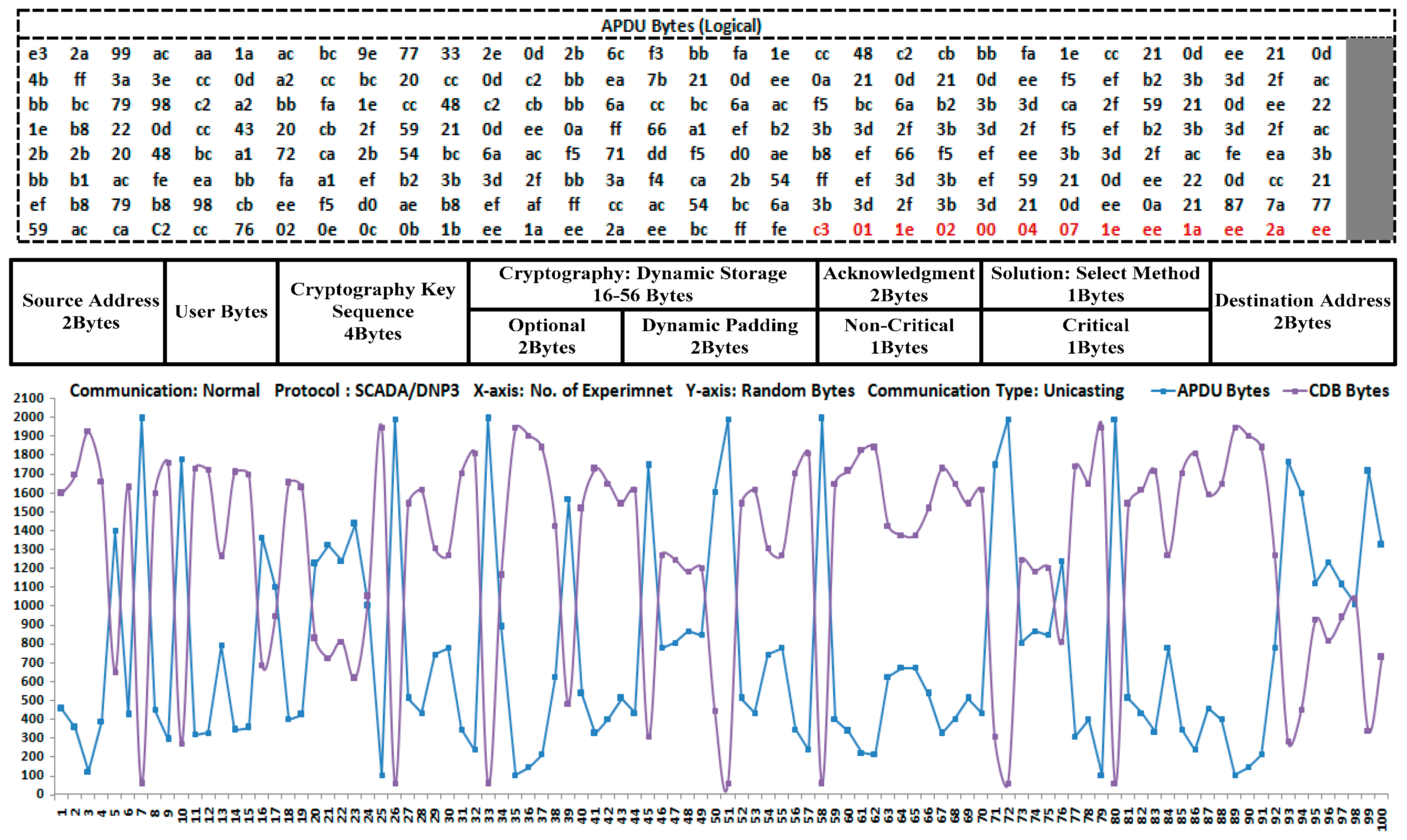
8.2. Cryptograph
| Notations | Descriptions |
|---|---|
| Encryption (Eny) functionof fragmentor APDU bytes. | |
| Security-development functions: Symmetric (), Asymmetric (), and Hashing (), and combined as hybrid (Hy) function during encryption/decryption process. | |
| Shared Secret Key () used by sender (S), Sender Private Key (), Target (T) or Receiver Public Key (), and Sender (S) Hashing (). | |
| (,) | Computed values after deployment of encryption, with bytes (b) andis designated for number of sender (S) keys (k) that are applied during encryption, and are member of Message (M) |
| ( | (initialized and show the work done after the encryption process, and they are members of Work done (W). |
| or complete payload after encryption process. | |
| Decryption (Dny) functionof. | |
| Hash comparisonfunctionand computed hash values (val) as | |
| Shared Secret Key () used at target (T) side, target (T) Private Key (), Sender (S) Public Key (), and Target (T) Hashing (). | |
| Assemble ()functionis used to assemble the constructed application-layer bytesto the lower-layer bytes. | |
| Reassemble ()functionis used to reassemble the protocol bytes (with the user-layer bytes |
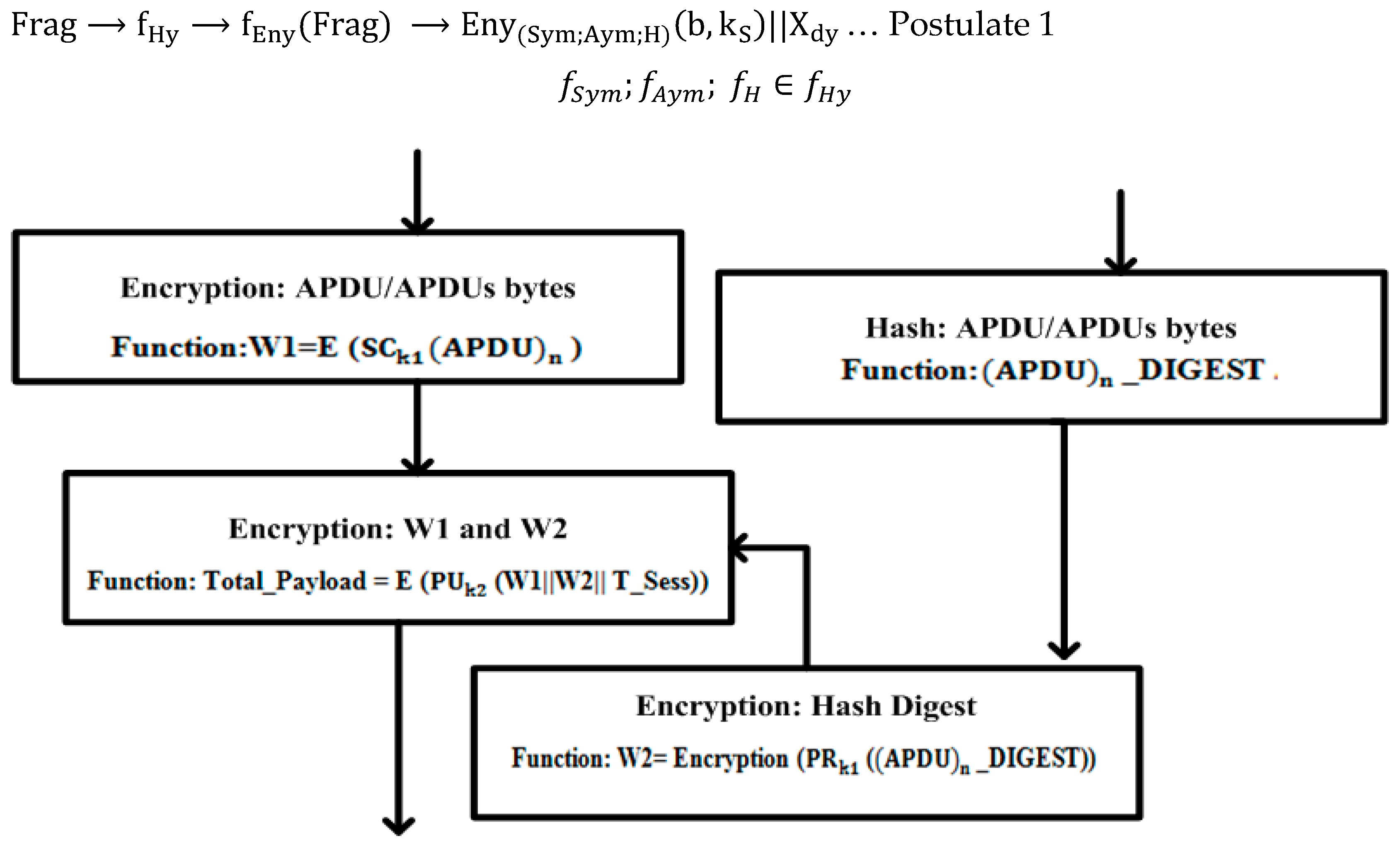
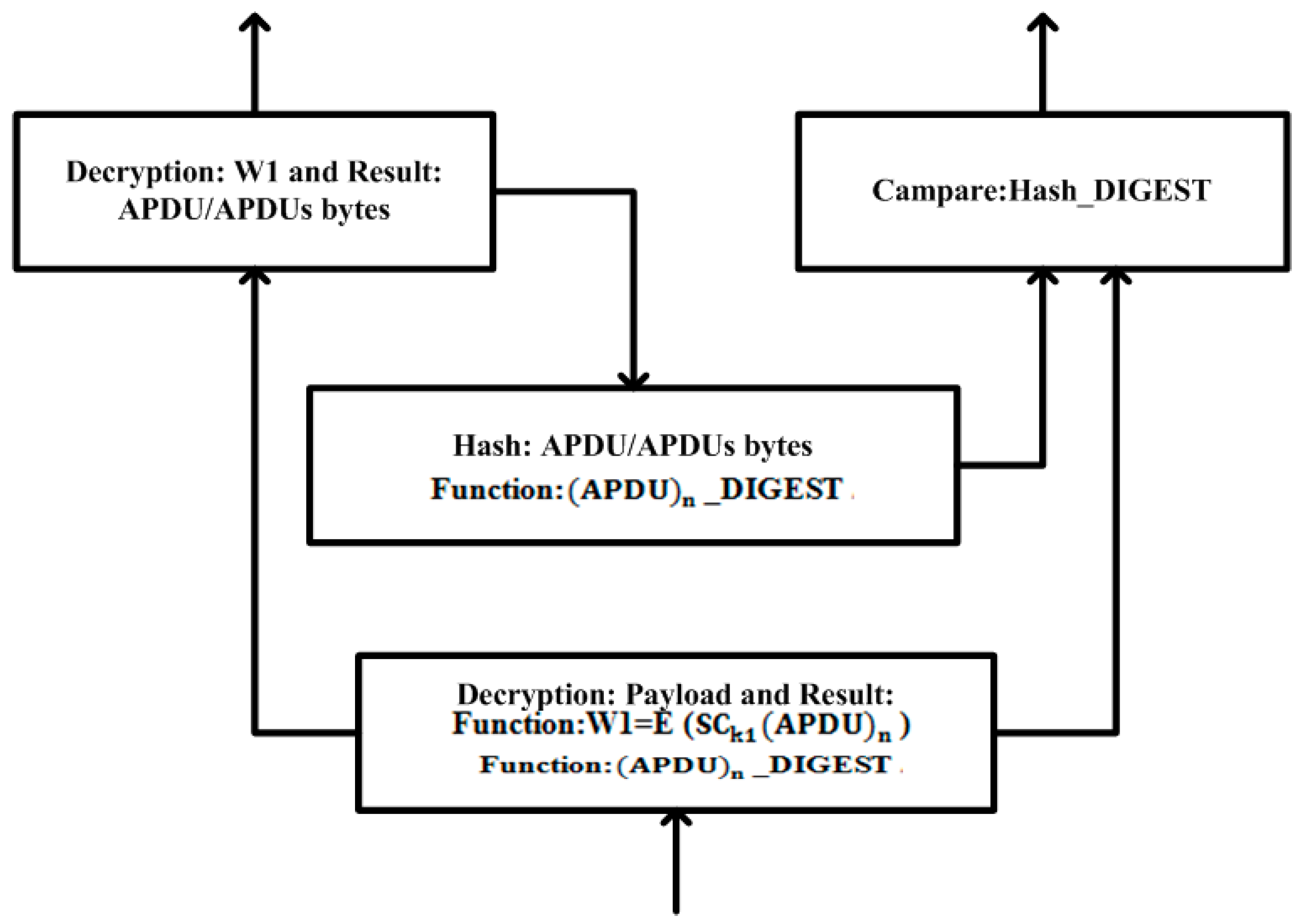
9. Results and Discussion
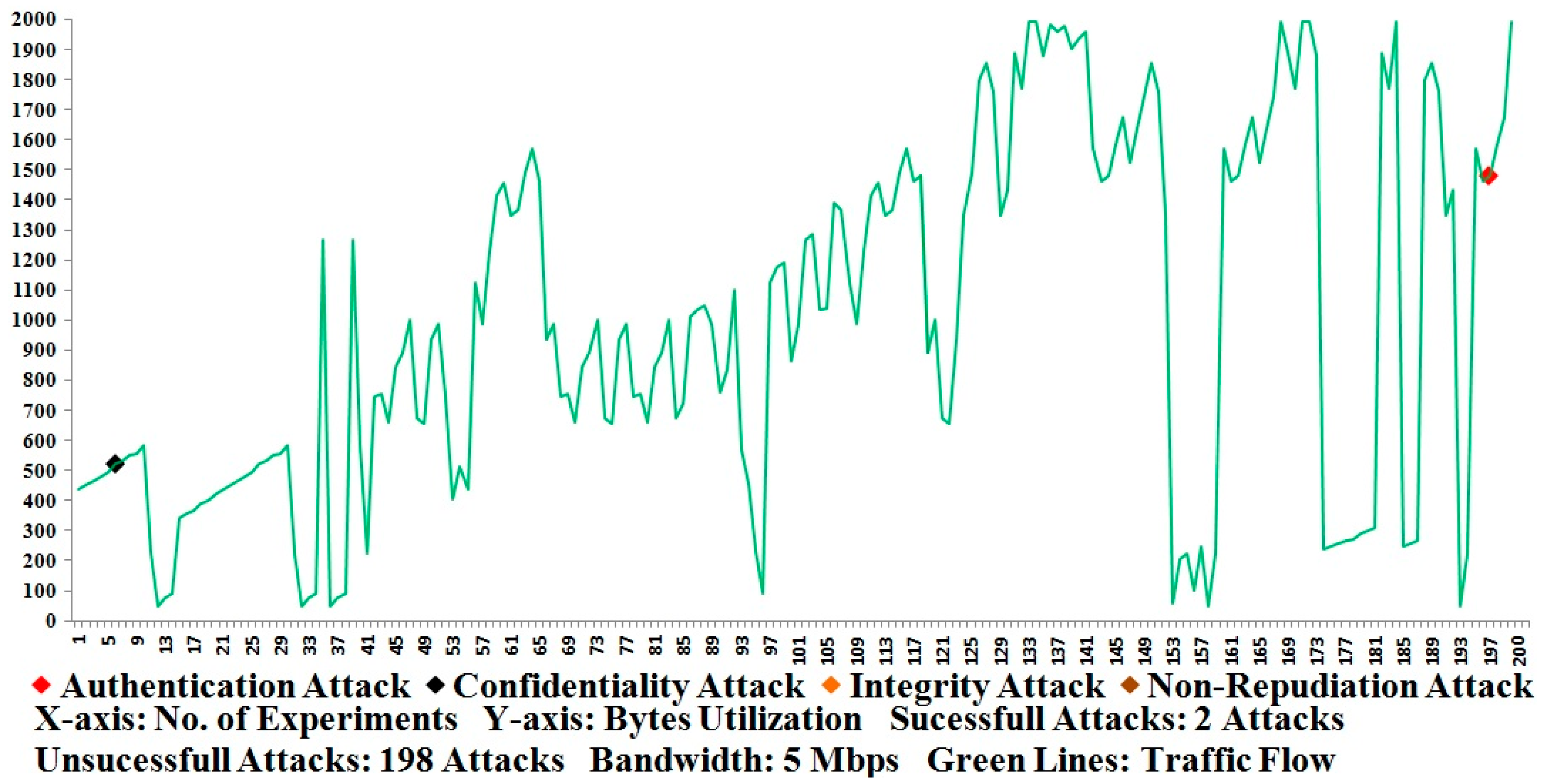
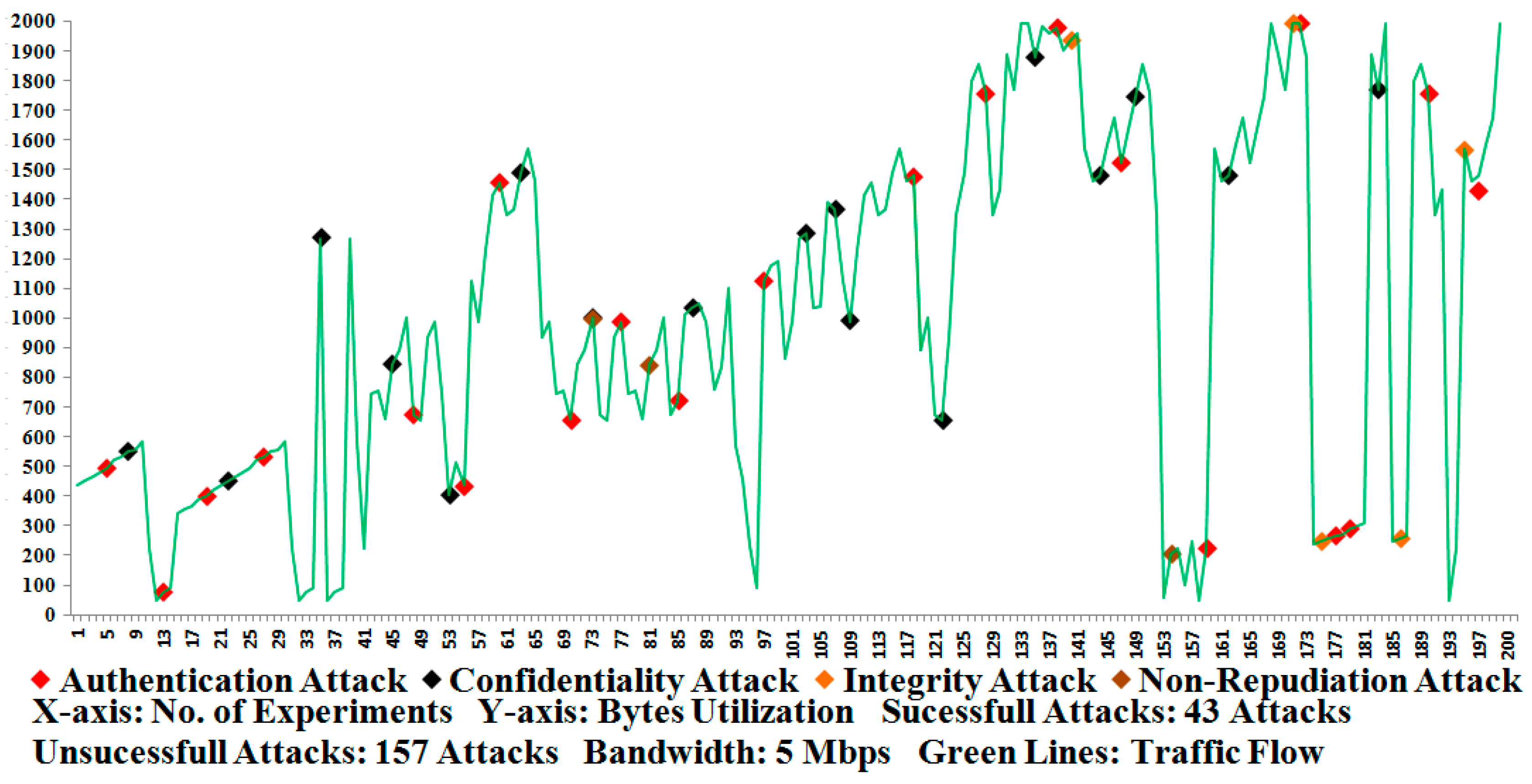
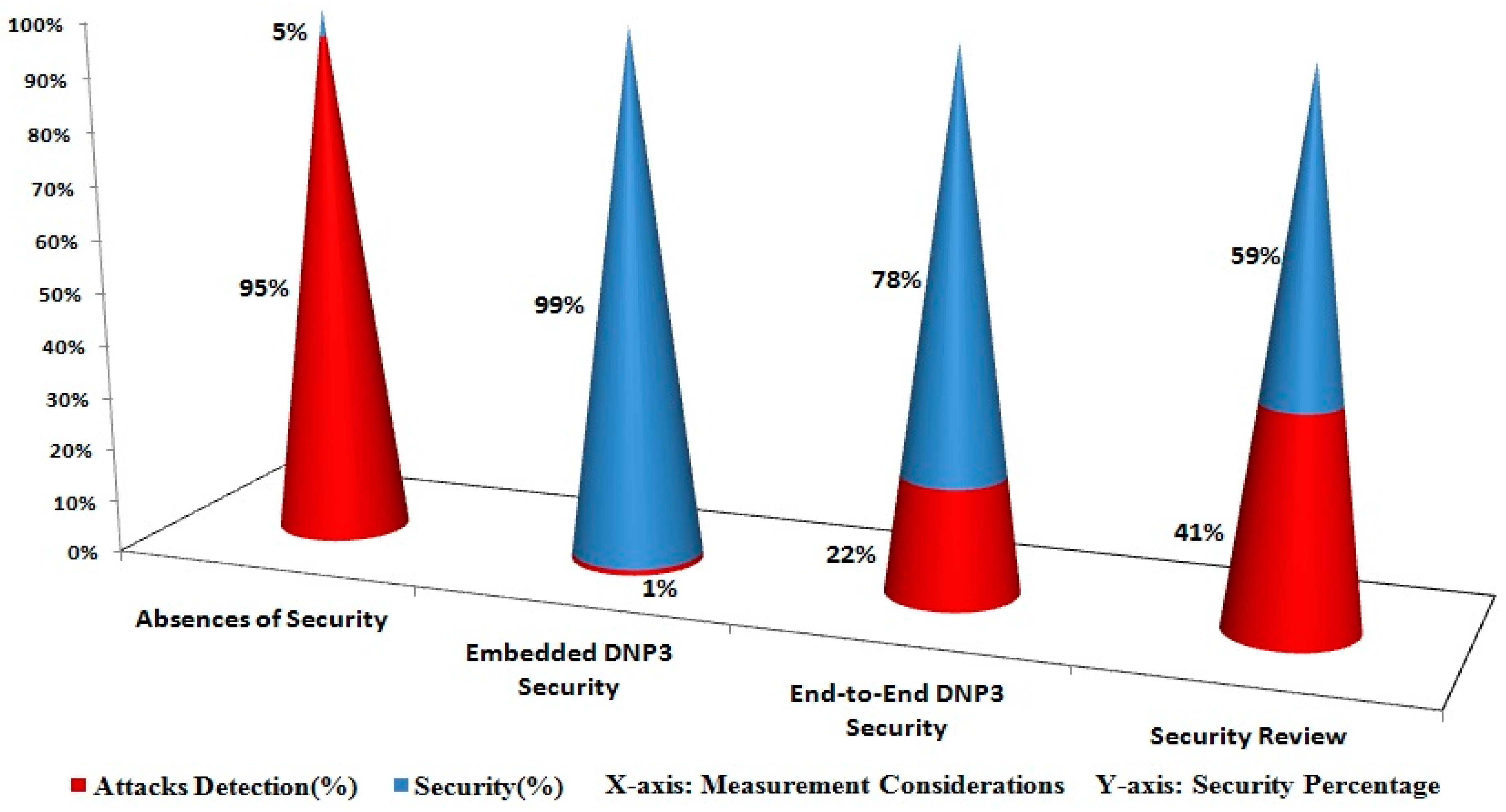
10. Conclusions and Future Work
Acknowledgments
Author Contributions
Conflicts of Interest
References
- Gao, J.; Liu, J.; Rajan, B.; Nori, R.; Fu, B.; Xiao, Y.; Liang, W.; Chen, P.C. SCADA communication and security issues. Secur. Commun. Netw. 2014, 7, 175–194. [Google Scholar] [CrossRef]
- National Communications System; Technical Information Bulletin 04-1; Supervisory Control and Data Acquisition (SCADA) Systems: Arlington, TX, USA, 2004.
- Stouffer, J.; Kent, K. Guide to Supervisory Control and Data Acquisition (SCADA) and Industrial Control Systems Security; Recommendations of the National Institute of Standards and Technology; NIST: Gaithersburg, MD, USA, 2006. [Google Scholar]
- Juniper Networks. Architecture for Secure SCADA and Distributed Control System Networks; White Paper; Juniper Networks, Inc: Sunnyvale, CA, USA, 2010. [Google Scholar]
- Musa, S.; Shahzad, A.; Aborujilah, A. Secure security model implementation for security services and related attacks base on end-to-end, application layer and data link layer security. In Proceedings of the 7th International Conference on Ubiquitous Information Management and Communication, Kota Kinabalu, Malaysia, 17–19 January 2013. [CrossRef]
- Nasim, B.M.; Jelena, M.; Vojislav, B.M.; Hamzeh, K. A framework for intrusion detection system in advanced metering infrastructure. Secur. Commun. Netw. 2012, 7. [Google Scholar] [CrossRef]
- Shahzad, A.; Malrey, L.; Changhoon, L.; Naixue, X.; Suntae, K.; Young, L.; Kangmin, K.; Seon, W.; Gisung, J. The protocol design and New approach for SCADA security enhancement during sensors broadcasting system. Multimedia Tools and Applications 2015, 1–28. [Google Scholar] [CrossRef]
- DNP Users Group. DNP3 Application Layer Specification; DNP Organization: Washington, WA, USA; Volume 2, Version 2.00.2005.
- Clarke, G.; Reynders, D.; Wright, E. Practical Modern SCADA Protocols: DNP3, 60870.5 and Related Systems; Elsevier: New York, NY, USA, 2004. [Google Scholar]
- Zhu, B.; Joseph, A.; Sastry, S. A Taxonomy of Cyber Attacks on SCADA Systems. In Proceedings of the 2011 International Conference on Internet of Things and 4th International Conference on Cyber, Physical and Social Computing, Washington, DC, USA, 19 October 2011; pp. 380–388.
- Hong, S.; Lee, M. Challenges and Direction toward Secure Communication in the SCADA System. In Proceedings of the 8th Annual Communication Networks and Services Research Conference, Montreal, QC, Canada, 11–14 May 2010.
- Badra, M.; Zeadally, S. Design and Performance Analysis of a Virtual Ring Architecture for Smart Grid Privacy. IEEE Trans. Inf. Forensics Secur. 2014, 9. [Google Scholar] [CrossRef]
- Lee, E.A. The Past, Present and Future of Cyber-Physical Systems: A Focus on Models. Sensors 2015, 15, 4837–4869. [Google Scholar] [CrossRef] [PubMed]
- Patel, S.C.; Bhatt, G.D.; Graham, J.H. Improving the cyber security of SCADA communication networks. Commun. ACM 2009, 52. [Google Scholar] [CrossRef]
- Patel, S.C.; Graham, J.H. Secure Internet-Based Communication Protocol for Scada Networks; University of Louisville: Louisville, KY, USA, 2006. [Google Scholar]
- Ali, S.; Qaisar, S.B.; Saeed, H.; Khan, M.F.; Naeem, M.; Anpalagan, A. Network Challenges for Cyber Physical Systems with Tiny Wireless Devices: A Case Study on Reliable Pipeline Condition Monitoring. Sensors 2015, 15, 7172–7205. [Google Scholar] [CrossRef] [PubMed]
- Moon, D.; Im, H.; Lee, J.D.; Park, J.H. MLDS: Multi-Layer Defense System for Preventing Advanced Persistent Threats. Symmetry 2014, 6, 997–1010. [Google Scholar] [CrossRef]
- Jang, U.; Lim, H.; Kim, H. Privacy-Enhancing Security Protocol in LTE Initial Attack. Symmetry 2014, 6, 1011–1025. [Google Scholar] [CrossRef]
- Davis, C.M.; Tate, J.E.; Okhravi, H.; Grier, C.; Overbye, T.J.; Nicol, D. SCADA Cyber Security Testbed Development. In Proceedings of the 38th North American Power Symposium, NAPS 2006, Carbondale, IL, USA, 17–19 September 2006. [CrossRef]
- Horvath, P.; Yampolskiy, M.; Koutsoukos, X. Efficient Evaluation of Wireless Real-Time Control Networks. Sensors 2015, 15, 4134–4153. [Google Scholar] [CrossRef] [PubMed]
- Yao, A.C.-C.; Zhao, Y. Privacy-Preserving Authenticated Key-Exchange over Internet. IEEE Trans. Inf. Forensics Secur. 2014, 9. [Google Scholar] [CrossRef]
- Zio, E.; Sansavini, G. Vulnerability of Smart Grids with Variable Generation and Consumption: A System of Systems Perspective. IEEE Trans. Syst. Man Cybern. Syst. 2013, 43. [Google Scholar] [CrossRef]
- Kang, D.-J.; Kim, H.-M. Development of test-bed and security devices for SCADA communication in electric power system. In Proceedings of the 31st International Telecommunications Energy Conference, INTELEC 2009, Incoeon, Korea, 18–22 October 2009. [CrossRef]
- Kim, T.-H. Hiding solution for internet-based supervisory control and data acquisition (SCADA) system threats management. Afr. J. Bus. Manag. 2012, 6, 10974–10982. [Google Scholar]
- Kang, D.-J.; Kim, H.-M. A Proposal for Key Policy of Symmetric Encryption Application to Cyber Security of KEPCO SCADA Network. Future Gen. Commun. Netw. (FGCN 2007) 2007, 2. [Google Scholar] [CrossRef]
- Backes, M.; Pfitzmann, B. A cryptographically sound security proof of the Needham-Schroeder-Lowe public-key protocol. IEEE J. Sel. Areas Commun. 2004, 22. [Google Scholar] [CrossRef]
- Almalawi, A.; Tari, Z.; Khalil, I.; Fahad, A. SCADAVT-A framework for SCADA security testbed based on virtualization technology. In Proceedings of the 2013 IEEE 38th Conference on Local Computer Networks (LCN), Sydney, NSW, Australia, 21–24 October 2013. [CrossRef]
- Alcaraz, C.; Fernandez, G.; Carvajal, F. Security Aspects of SCADA and DCS Environments. In Critical Infrastructure Protection; Springer: Berlin Heidelberg, Garmany, 2012; Volume 7130, pp. 120–149. [Google Scholar]
- Shahzad, A.; Musa, S.; Aborujilah, A.; Irfan, M. The security survey and anaylsis on supervisory control and data acquisition communication. J. Comput. Sci. 2014, 10, 2006–2019. [Google Scholar] [CrossRef]
- Lim, I.H.; Hong, S.; Choi, M.S.; Lee, S.J.; Lee, S.W.; Ha, B.N. Applying security algorithms against cyber attacks in the distribution automation system. In Proceedings of the Transmission and Distribution Conference and Exposition, Chicago, IL, USA, 21–24 April 2008. [CrossRef]
- Laih, C.S.; Ding, L.; Huang, Y.M. Password-only authenticated key establishment protocol without public key cryptography. Electron. Lett. 2005, 41. [Google Scholar] [CrossRef]
- Queiroz, C.; Mahmood, A.; Hu, J.; Tari, Z.; Yu, X. Building a SCADA Security Testbed. In Proceedings of the Third International Conference on Network and System Security, NSS’09, Gold Coast, QLD, Australia, 19–21 October 2009. [CrossRef]
- Eskicioglu, A.M.; Delp, E.J. A key transport protocol based on secret sharing applications to information security. IEEE Trans. Consum. Electron. 2002, 48. [Google Scholar] [CrossRef]
- Drahansky, M.; Balitanas, M. Cipher for Internet-based Supervisory Control and Data Acquisition Architecture. J. Secur. Eng. 2011, 8. [Google Scholar] [CrossRef]
- Ma, S.; Huang, Q.; Zhang, M.; Yang, B. Efficient Public Key Encryption with Equality Test Supporting Flexible Authorization. IEEE Trans. Inf. Forensics Secur. 2015, 10, 478–480. [Google Scholar]
- Kim, S.-H.; Lee, I.-Y. Study on User Authority Management for Safe Data Protection in Cloud Computing Environments. Symmetry 2015, 7, 269–283. [Google Scholar] [CrossRef]
- Nam, J.; Choo, K.-K.R.; Han, S.; Paik, J.; Won, D. Two-Round Password-Only Authenticated Key Exchange in the Three-Party Setting. Symmetry 2015, 7, 105–124. [Google Scholar] [CrossRef]
- Shbib, R.; Zhou, S.; Alkadhimi, K. SCADA System Security, Complexity, and Security Proof. In Pervasive Computing and the Networked World; Springer: Istanbul, Turkey, 28–30 November 2013; pp. 405–410. [Google Scholar]
- Wang, Y. Chapter 1: Smart Grid, Automation, and SCADA Systems Security. In World Scientific Review; University of North Carolina: Charlotte, NC, USA, 2012. [Google Scholar]
- Robles, R.-J.; Balitanas, M. Comparison of Encryption Schemes as Used in Communication between SCADA Components. In Proceedings of the Ubiquitous Computing and Multimedia Applications (UCMA), Daejeon, Korea, 13–15 April 2011. [CrossRef]
- Faruk, A. Testing & Exploring Vulnerabilities of the Applications Implementing DNP3 Protocol. Master Thesis, KTH, Stockholm, Sweden, 2008. [Google Scholar]
- Oman, P.; Phillips, M. Intrusion detection and event monitoring in SCADA networks. In Critical Infrastructure Protection; Goetz, E., Shenoi, S., Eds.; Springer: New York, NY, USA, 2007; Volume 253, pp. 161–173. [Google Scholar]
- Riaz, R.; Naureen, A.; Akram, A.; Akbar, A.H.; Kim, K.H.; Ahmed, H.F. A unified security framework with three key management schemes for wireless sensor networks. Comput. Commun. 2008, 31, 4269–4280. [Google Scholar] [CrossRef]
- Kim, S.-J.; Cho, D.-E.; Yeo, S.-S. Secure Model against APT in m-Connected SCADA Network. Int. J. Distrib. Sens. Netw. 2014, 2014. [Google Scholar] [CrossRef]
- Nabil, S.; Mohamed, B. Security solution for semantic SCADA optimized by ECC mixed coordinates. In Proceedings of the 2012 International Conference on Information Technology and e-Services (ICITeS), Sousse, Tunisia, 24–26 March 2012. [CrossRef]
- Shahzad, A.; Udagepola, K.P.; Lee, Y.-K.; Park, S.; Lee, M. The Sensors Connectivity within SCADA Automation Environment and New Trends for Security Development during Multicasting Routing Transmission. Int. J. Distrib. Sens. Netw. 2015. [Google Scholar] [CrossRef]
- Chikuni, E.; Dondo, M. Investigating the security of electrical power systems SCADA. In Proceedings of the AFRICON 2007, Windhoek, South Africa, 26–28 September 2007. [CrossRef]
- Yeh, H.-T.; Sun, H.-M.; Hwang, T. Security analysis of the generalized key agreement and password authentication protocol. IEEE Commun. Lett. 2001, 5. [Google Scholar] [CrossRef]
- Irshad, A.; Sher, M.; Faisal, M.S. A secure authentication scheme for session initiation protocol by using ECC on the basis of the Tang and Liu scheme. Secur. Commun. Netw. 2014. [Google Scholar] [CrossRef]
- Kim, Y.-S.; Heo, J. Device authentication protocol for smart grid systems using homomorphic hash. J. Commun. Netw. 2012, 14, 606–613. [Google Scholar] [CrossRef]
- Saxena, A.; Pal, O.; Saquib, Z. Public Key Cryptography Based Approach for Securing SCADA Communications. Commun. Comput. Inf. Sci. 2011, 142, 56–62. [Google Scholar]
- Shahzad, A.; Musa, S.; Irfan, M.; Asadullah, S. Deployment of New Dynamic Cryptography Buffer for SCADA Security Enhancement. J. Appl. Sci. 2014, 14, 2487–2497. [Google Scholar] [CrossRef]
- Sommestad, T.; Ericsson, G.N.; Nordlander, J. SCADA system cyber security—A comparison of standards. In Proceedings of the 2010 IEEE Power and Energy Society General Meeting, Minneapolis, MN, USA, 25–29 July 2010. [CrossRef]
- Yun, J.-H.; Jeon, S.-H.; Kim, K.-H.; Kim, W.-N. Burst-Based Anomaly Detection on the DNP3 Protocol. Int. J. Control Autom. 2013, 6, 313–324. [Google Scholar]
- Jin, D.; Nicol, D.M.; Yan, G. An event buffer flooding attack in DNP3 controlled SCADA systems. In Proceedings of the Winter Simulation Conference (WSC‘11), Phoenix, AZ, USA, 11–14 December 2011; pp. 2619–2631.
- Lee, D.; Kim, H.; Kim, K.; Yoo, P.D. Simulated Attack on DNP3 Protocol in SCADA System. In Proceedings of the 31st Symposium on Cryptography and Information Security Kagoshima, Kagoshima, Japan, 21–24 January 2011.
- East, S.; Butts, J.; Papa, M.; Shenoi, S. A Taxonomy of Attacks on the DNP3 Protocol; Critical Infrastructure Protection III; Springer Berlin Heidelberg: Berlin, Germany, 2009; pp. 67–81. [Google Scholar]
- DNP Users Group. DNP3 Specification, Secure Authentication; DNP Organization: Washington, WA, USA, 2013; Version 5 Overview. [Google Scholar]
- Majdalawieh, M.; Parisi-Presicce, F.; Wijesekera, D. DNPSec: Distributed Network Protocol Version 3 (DNP3) Security Framework. In Advances in Computer, Information, and Systems Sciences, and Engineering; Springer: Dordrecht, the Netherlands, 2006; pp. 227–234. [Google Scholar]
- Palmer, C.; Shenoi, S. Critical Infrastructure Protection III. In Proceedings of the Third IFIP WG 11.10 International Conference, Hanover, NH, USA, 23–25 March 2009.
- Shahzad, A.; Lee, M.; Lee, Y.K.; Kim, S.; Xiong, N.; Choi, J.Y.; Cho, Y. Real Time MODBUS Transmissions and Cryptography Security Designs and Enhancements of Protocol Sensitive Information. Symmetry 2015, 7. [Google Scholar] [CrossRef]
- Pinkas, B.; Sander, T. Securing Passwords Against Dictionary Attacks. Available online: http://www.pinkas.net/PAPERS/pwdweb.pdf (accessed on 12 February 2015).
- An Ettercap Primer. Available online: http://www.sans.org/reading-room/whitepapers/tools/ettercap-primer-1406 (accessed on 12 February 2015).
- Ethereal. Available online: http://www.engr.siu.edu/~weng/ece553/wireshark-tutorial.pdf (accessed on 26 February 2015).
- Aircrack. Available online: http://www.aircrack-ng.org/doku.php?id=cracking_wpa (accessed on 5 March 2015).
- Air Snort. Available online: http://www.scribd.com/doc/50711790/airsnort-tutorial#scribd (accessed on 25 March 2015).
- Packet Sniffer. Available online: https://www.mikrotik.com/testdocs/ros/2.9/tools/sniffer.pdf (accessed on 25 March 2015).
- Dniffer. Available online: http://www.giac.org/paper/gsec/810/introduction-dsniff/101714 (accessed on 27 March 2015).
- Airpwn. Available online: http://airpwn.sourceforge.net/Documentation.html (accessed on 28 March 2015).
- File2air. Available online: http://www.willhackforsushi.com/?page_id=126 (accessed on 1 April 2015).
- Son, S.; McKinley, K.S.; Shmatikov, V. Diglossia: Detecting Code Injection Attackswith Precision and Efficiency. 2013. Available online: https://www.cs.utexas.edu/~shmat/shmat_ccs13.pdf (accessed on 10 April 2015).
- Da Silva Pereira, C.C.; Shinoda, A.A.; de Oliveira, R.; do Nascimento, V.E.; Ferreira, E.W.T. A NS-2 simulation model for DNP3 protocol over IEEE 802.15.4 wireless protocol toward low cost simulation of Smart Grid applications. In Proceedings of the 2014 IEEE Colombian Conference on Communications and Computing (COLCOM), Bogota, Columbia, 4–6 June 2014.
- Choi, M. Wireless Communications for SCADA Systems Utilizing Mobile Nodes. Int. J. Smart Home 2013, 7, 1–8. [Google Scholar] [CrossRef]
- Pietraszek, T.; Berghe, C.V. Defending against injection attacks through context-sensitive string evaluation. In Proceedings of the 8th International Conference on Recent Advances in Intrusion Detection (RAID’05), Seattle, WA, USA, 7–9 September 2005; pp. 124–145.
© 2016 by the authors; licensee MDPI, Basel, Switzerland. This article is an open access article distributed under the terms and conditions of the Creative Commons by Attribution (CC-BY) license (http://creativecommons.org/licenses/by/4.0/).
Share and Cite
Shahzad, A.; Lee, M.; Kim, S.; Kim, K.; Choi, J.-Y.; Cho, Y.; Lee, K.-K. Design and Development of Layered Security: Future Enhancements and Directions in Transmission. Sensors 2016, 16, 37. https://doi.org/10.3390/s16010037
Shahzad A, Lee M, Kim S, Kim K, Choi J-Y, Cho Y, Lee K-K. Design and Development of Layered Security: Future Enhancements and Directions in Transmission. Sensors. 2016; 16(1):37. https://doi.org/10.3390/s16010037
Chicago/Turabian StyleShahzad, Aamir, Malrey Lee, Suntae Kim, Kangmin Kim, Jae-Young Choi, Younghwa Cho, and Keun-Kwang Lee. 2016. "Design and Development of Layered Security: Future Enhancements and Directions in Transmission" Sensors 16, no. 1: 37. https://doi.org/10.3390/s16010037
APA StyleShahzad, A., Lee, M., Kim, S., Kim, K., Choi, J.-Y., Cho, Y., & Lee, K.-K. (2016). Design and Development of Layered Security: Future Enhancements and Directions in Transmission. Sensors, 16(1), 37. https://doi.org/10.3390/s16010037






